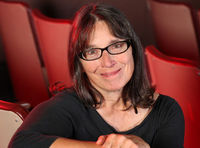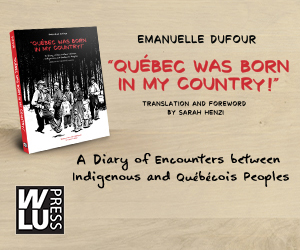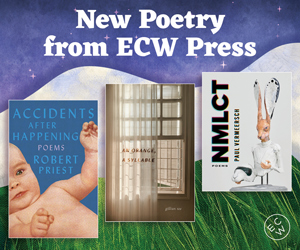On Writing, with Julie Salverson
Julie Salverson has written plays, operas, scholarly texts, and non-fiction, but her newest book, a memoir, may be her most unique work yet. Lines of Flight (Wolsak & Wynn) traces her ten-year journey exploring the connection between the Canadian North and the atomic bomb dropped on Japan.
As an instructor who has helped countless people translate personal trauma into plays and stories, the collective trauma of the Japanese people and the worldwide anxiety of living under the threat of Nuclear war became a powerful engine for the book's progress. Lines of Flight maintains a through-line of hope despite its difficult subject matter, and asks the provocative questions of how we are to live in a world filled with beautiful terror and terrible beauty.
We're pleased to welcome Julie to Open Book today to talk to us about Lines of Flight. She tells us about that little-known Canadian connection to the bombing in Hiroshima, the psychological effects of living in the Nuclear era, and her experience discovering the Canadian North.
Open Book:
How did you first discover the connection between the bombing of Japan during the Second World War and Canada's north? When and how did you know this would become a book for you?
Julie Salverson:
In 2001 a friend – Peter Van Wyck from Concordia University – told me that uranium from Deline, Northwest Territories had contributed to the bombing of Hiroshima. I then watched the documentary Village of Widows by Peter Blow. What stunned me was not only the existence of El Dorado, the mine on Great Bear Lake, but learning that in 1998 the Sahtúgot’ine Bear Lake People had sent a delegation to Hiroshima to apologize. Blow took his camera and recorded the visit in his film. I decided to travel the highway of the uranium, from Deline to New Mexico to Japan. I made notes for several years as I started this journey, and I wrote an opera called Shelter, but the story kept growing and growing. In 2008 I went to the Banff Centre with all my notebooks. I did a creative non-fiction workshop with Myrna Kostash. It was that week in Banff that showed me I had a book. I returned to Banff twice more, for the Writing Studio and the Literary Journalism program. I would never have gotten this written, or believed I could write it, without the Banff Centre.
OB:
Nuclear weapons are taking centre stage once again in international discussions. How do you view the current conversation around nuclear weapons and what effect do you think living with the spectre of nuclear war has on people?
JS:
If you had told me when I was writing this book that an incoming president of the United States would be talking about using nuclear weapons and dissolving NATO, I would have laughed. Does the book speak to this? Absolutely. I think Canada is now in an important position to offer a voice of moderation and sanity. I hope we can do that.
After Fukushima, philosopher Jean-Luc Nancy said: “Is there an after? Is there anything that follows? Are we still headed somewhere?” Living with the threat of not only nuclear war but climate change, the crisis over water – puts people into a constant low-level stress. Our brains and bodies are on alert, always waiting for disaster. It’s a kind of trauma that we aren’t explicit about, but we should be. I write about this in the book. In Hiroshima in America: Fifty Years of Denial, Robert Jay Lifton and Greg Mitchell write that since 1945, personal losses - the death of a loved one, dislocation from home - have merged with extreme threat. “Just as, after Hiroshima, every antagonism between nations takes on the potential for destroying the entire world, so does every personal trauma potentially take on that end-of-the-world association.” Every danger we experience, public or private, puts us psychically on the edge of disaster, worrying about the next emergency: an earthquake in Japan, an oil spill in the Gulf, a friend with cancer, an alcoholic parent.
I think that recognizing this helps, and lets us make conscious steps to offer our traumatized brains something else - an evening with people we trust, a weekend in the garden or the woods; time to daydream, imagine, relax, read poetry and fiction!
OB:
This book took you on a long journey. Tell us a little about your travels and research process in writing Lines of Flight.
Your CanLit News
Subscribe to Open Book’s newsletter to get local book events, literary content, writing tips, and more in your inbox
JS:
This was an adventure that unfolded one step at a time. I flew with Peter to Deline, NWT in 2002, my first time in northern Canada. It blew my mind how here was this huge part of Canada I knew nothing about. On that first trip I was preoccupied with the story of the uranium mine, the incidents of cancer in the community. I’d say I was only seeing victims and yet here in front of me was a lively, engaged place, bursting with projects and energy. Problems too, of course, but so much vitality. I then went to New Mexico and seeing site of the first nuclear test site was an unforgettable, chilling experience. A few years went by, I wrote some material, but I couldn’t get very far. I realized I had to go to Japan. Peter was finished his book Highway of the Atom by then, so I flew to Hiroshima myself. I arrived just before Christmas, families were celebrating on the streets right where the bomb had fallen. What a perfect way to upset my expectations.
The travel is one thing, but the more unsettling and eventually crucial part of the research process was realizing the book had to be a memoir. The idea horrified me at first, but whenever I read aloud from my material, people said, “We want more of you. This is an ‘everyman’ story.” So, I reached back into my own memories, of being the child of alcoholics and searching for safety, of being a young activist trying to save the world from the danger I knew waited there, of going to Nicaragua to see a revolution. In the end, the research is this mix of personal and social investigation. I also wanted to bring in some of the theory and writing I had encountered in graduate school, ideas that had a power to make more meaning of this for me. And, hopefully, for others. I wanted to translate those theories for a general reader.
OB:
Are there works of fiction or films that you have found that you feel deal intelligently with issues around atomic weapons, nuclear war, and related subjects? If so, which would you recommend?
JS:
I saw a film years ago called Desert Bloom. It captures the precarity of a young girl’s home life and the nuclear testing going on around her. It takes place in the 1950’s in Nevada, I think, and after I saw it I went into a restaurant washroom and threw up. At a visceral level, it was both my childhood and this atomic world I was fascinated by. It’s a beautiful film. Shaena Lambert has a stunning novel about Hiroshima Maidens, the young women who were brought over to North America after 1945 to have their faces restored by plastic surgery. Radiance shows the complicated postwar attitude to the Japanese, the bombing, and where helping is useful and where it is a kind of voyeuristic consuming of spectacle. It’s a great read, too. Another fascinating novel is James Flint’s The Book of Ash, an atomic adventure of a man searching for his lost father through the nuclear landscape of America. The character of the father is based on the American sculptor James L Acord, who spent his life trying to make art out of radioactive waste. Then, for the psychic costs of atomic culture, the Hiroshima in America book I mentioned earlier, and a less known and superb link between the psychological, the social and the philosophical in the American psyche, Death’s Dream Kingdom by Walter A. David. Finally, I’ve been told my book reminds some people of Edward Burtynsky’s photographs, because it is about beauty in what is at first only terrible. I guess that means the terrible knowledge of what we as humans keep doing, but the beauty of being alive, nonetheless.
OB:
What will you be working on next?
JS:
A couple of things! I am writing a book connected to my father. George Salverson was a radio and television writer and the first head of television drama for the CBC. In 1962 he flew around the world shooting a documentary on world hunger that was commissioned by the World Health Organization in Rome. I have his seven filled notebooks describing who he met, what happened, what he felt. I’m starting to follow his footsteps, or some of them, and tell both his story (using the notebooks) and asking, what is the world hungry for now? What does resilience, and sustenance, look like? Right now it’s a combination of fiction and non-fiction – we’ll see how that works out!
I’m also editing a collection of Canadian libretti for Playwright’s Canada Press, due out in 2019. And, with fellow playwright John Lazarus, writing a short book of exercises for writers called Games Playwrights Play.
__________________________________________
Julie Salverson is a playwright, librettist, scholar, and non-fiction writer who teaches drama at Queen’s University and the Royal Military College of Canada. She has published essays about the artist as witness, atomic culture, ethics, and the imagination. Salverson has created projects in community engaged arts practice for many years, and works with groups to practice resiliency through the exchange and development of stories. She is a member of the Playwright’s Guild of Canada and her plays have been produced in Canada, the US and Thailand. Visit her website at https://jsalverson.wordpress.com/.



